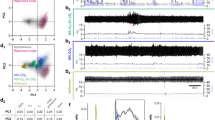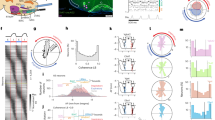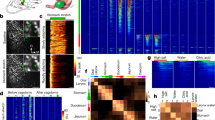Abstract
A long-standing theory posits that central chemoreception, the CNS mechanism for CO2 detection and regulation of breathing, involves neurons located at the ventral surface of the medulla oblongata (VMS). Using in vivo and in vitro electrophysiological recordings, we identify VMS neurons within the rat retrotrapezoid nucleus (RTN) that have characteristics befitting these elusive chemoreceptors. These glutamatergic neurons are vigorously activated by CO2 in vivo, whereas serotonergic neurons are not. Their CO2 sensitivity is unaffected by pharmacological blockade of the respiratory pattern generator and persists without carotid body input. RTN CO2-sensitive neurons have extensive dendrites along the VMS and they innervate key pontomedullary respiratory centers. In brainstem slices, a subset of RTN neurons with markedly similar morphology is robustly activated by acidification and CO2. Their pH sensitivity is intrinsic and involves a background K+ current. In short, the CO2-sensitive neurons of the RTN are good candidates for the long sought-after VMS chemoreceptors.
This is a preview of subscription content, access via your institution
Access options
Subscribe to this journal
Receive 12 print issues and online access
$209.00 per year
only $17.42 per issue
Buy this article
- Purchase on Springer Link
- Instant access to full article PDF
Prices may be subject to local taxes which are calculated during checkout






Similar content being viewed by others
References
Feldman, J.L., Mitchell, G.S. & Nattie, E.E. Breathing: rhythmicity, plasticity, chemosensitivity. Annu. Rev. Neurosci. 26, 239–266 (2003).
Richerson, G.B. Serotonergic neurons as carbon dioxide sensors that maintain pH homeostasis. Nat. Rev. Neurosci. 5, 449–461 (2004).
Ballantyne, D. & Scheid, P. Central chemosensitivity of respiration: a brief overview. Respir. Physiol. 129, 5–12 (2001).
Scheid, P., Putnam, R.W., Dean, J.B. & Ballantyne, D. (eds.) Special issue: central chemosensitivity. Respir. Physiol. Neurobiol. 129, 1–278 (2001).
Kawai, A., Ballantyne, D., Muckenhoff, K. & Scheid, P. Chemosensitive medullary neurones in the brainstem–spinal cord preparation of the neonatal rat. J. Physiol. (Lond.) 492, 277–292 (1996).
Nattie, E.E. Central chemosensitivity, sleep, and wakefulness. Respir. Physiol. 129, 257–268 (2001).
Mitchell, R.A., Loeschcke, H.H., Massion, W.H. & Severinghaus, J.W. Respiratory responses mediated through superficial chemosensitive areas on the medulla. J. Appl. Physiol. 18, 523–533 (1963).
Loeschcke, H.H. Central chemosensitivity and the reaction theory. J. Physiol. (Lond.) 332, 1–24 (1982).
Smith, J.C., Morrison, D.E., Ellenberger, H.H., Otto, M.R. & Feldman, J.L. Brainstem projections to the major respiratory neuron populations in the medulla of the cat. J. Comp. Neurol. 281, 69–96 (1989).
Cream, C., Li, A. & Nattie, E. The retrotrapezoid nucleus (RTN): local cytoarchitecture and afferent connections. Respir. Physiol. Neurobiol. 130, 121–137 (2002).
Ellenberger, H.H. & Feldman, J.L. Brainstem connections of the rostral ventral respiratory group of the rat. Brain Res. 513, 35–42 (1990).
Connelly, C.A., Ellenberger, H.H. & Feldman, J.L. Are there serotonergic projections from raphe and retrotrapezoid nuclei to the ventral respiratory group in the rat? Neurosci. Lett. 105, 34–40 (1989).
Weston, M.C., Stornetta, R.L. & Guyenet, P.G. Glutamatergic neuronal projections from the marginal layer of the rostral ventral medulla to the respiratory centers in rats. J. Comp. Neurol. 473, 73–85 (2004).
Okada, Y., Chen, Z., Jiang, W., Kuwana, S. & Eldridge, F.L. Anatomical arrangement of hypercapnia-activated cells in the superficial ventral medulla of rats. J. Appl. Physiol. 93, 427–439 (2002).
Sato, M., Severinghaus, J.W. & Basbaum, A.I. Medullary CO2 chemoreceptor neuron identification by c-fos immunocytochemistry. J. Appl. Physiol. 73, 96–100 (1992).
Onimaru, H. & Homma, I. A novel functional neuron group for respiratory rhythm generation in the ventral medulla. J. Neurosci. 23, 1478–1486 (2003).
Fukuda, Y., Tojima, H., Tanaka, K. & Chiba, T. Respiratory suppression by focal cooling of ventral medullary surface in anesthetized rats—functional and neuroanatomical correlate. Neurosci. Lett. 153, 177–180 (1993).
Orem, J. & Dick, T. Consistency and signal strength of respiratory neuronal activity. J. Neurophysiol. 50, 1098–1107 (1983).
Stornetta, R.L., Sevigny, C.P. & Guyenet, P.G. Inspiratory augmenting bulbospinal neurons express both glutamatergic and enkephalinergic phenotypes. J. Comp. Neurol. 455, 113–124 (2003).
Brown, D.L. & Guyenet, P.G. Electrophysiological study of cardiovascular neurons in the rostral ventrolateral medulla in rats. Circ. Res. 56, 359–369 (1985).
Sun, M.K. Pharmacology of reticulospinal vasomotor neurons in cardiovascular regulation. Pharmacol. Rev. 48, 465–494 (1996).
Bianchi, A.L., Denavit-Saubie, M. & Champagnat, J. Central control of breathing in mammals: neuronal circuitry, membrane properties, and neurotransmitters. Physiol. Rev. 75, 1–45 (1995).
Sun, M.K., Hackett, J.T. & Guyenet, P.G. Sympathoexcitatory neurons of rostral ventrolateral medulla exhibit pacemaker properties in the presence of a glutamate- receptor antagonist. Brain Res. 438, 23–40 (1988).
Gray, P.A., Rekling, J.C., Bocchiaro, C.M. & Feldman, J.L. Modulation of respiratory frequency by peptidergic input to rhythmogenic neurons in the PreBotzinger complex. Science 286, 1566–1568 (1999).
Manzke, T. et al. 5-HT4(a) receptors avert opioid-induced breathing depression without loss of analgesia. Science 301, 226–229 (2003).
Schreihofer, A.M. & Guyenet, P.G. Identification of C1 presympathetic neurons in rat rostral ventrolateral medulla by juxtacellular labeling in vivo. J. Comp. Neurol. 387, 524–536 (1997).
St-John, W.M. Neurogenesis of patterns of automatic ventilatory activity. Prog. Neurobiol. 56, 97–117 (1998).
Paxinos, G. & Watson, C. The Rat Brain in Stereotaxic Coordinates 4th edn. (Academic, San Diego, 1998).
Fremeau, R.T., Voglmaier, S., Seal, R.P. & Edwards, R.H. VGLUTs define subsets of excitatory neurons and suggest novel roles for glutamate. Trends Neurosci. 27, 98–103 (2004).
Mason, P. Contributions of the medullary raphe and ventromedial reticular region to pain modulation and other homeostatic functions. Annu. Rev. Neurosci. 24, 737–777 (2001).
Eldridge, F.L., Kiley, J.P. & Millhorn, D.E. Respiratory responses to medullary hydrogen ion changes in cats: different effects of respiratory and metabolic acidoses. J. Physiol. (Lond.) 358, 285–297 (1985).
Li, A. & Nattie, E. CO2 dialysis in one chemoreceptor site, the RTN: stimulus intensity and sensitivity in the awake rat. Respir. Physiol. Neurobiol. 133, 11–22 (2002).
Bayliss, D.A., Talley, E.M., Sirois, J.E. & Lei, Q.B. TASK-1 is a highly modulated pH-sensitive 'leak' K+ channel expressed in brainstem respiratory neurons. Respir. Physiol. 129, 159–174 (2001).
Washburn, C.P., Sirois, J.E., Talley, E.M., Guyenet, P.G. & Bayliss, D.A. Serotonergic raphe neurons express TASK channel transcripts and a TASK-like pH-and halothane-sensitive K+ conductance. J. Neurosci. 22, 1256–1265 (2002).
Putnam, R.W., Filosa, J.A. & Ritucci, N.A. Cellular mechanisms involved in CO2 and acid signaling in chemosensitive neurons. Am. J. Physiol. — Cell Physiol. 287, C1493–C1526 (2004).
Feldman, J.L. & McCrimmon, D.R. Neural control of breathing. in Fundamental Neuroscience (eds. Zigmond, M.J. et al.) 1063–1090 (Academic Press, San Diego, 1999).
Richerson, G.B. Response to CO2 of neurons in the rostral ventral medulla in vitro. J. Neurophysiol. 73, 933–944 (1995).
Veasey, S.C., Fornal, C.A., Metzler, C.W. & Jacobs, B.L. Response of serotonergic caudal raphe neurons in relation to specific motor activities in freely moving cats. J. Neurosci. 15, 5346–5359 (1995).
Nattie, E.E., Li, A., Richerson, G.B. & Lappi, D.A. Medullary serotonergic neurons and adjacent neurons that express neurokinin-1 receptors are both involved in chemoreception in vivo. J. Physiol. (Lond.) 556(Pt 1), 235–253 (2004).
Shigetomi, E. & Kato, F. Action potential-independent release of glutamate by Ca2+ entry through presynaptic P2X receptors elicits postsynaptic firing in the brainstem autonomic network. J. Neurosci. 24, 3125–3135 (2004).
Spyer, K.M., Dale, N. & Gourine, A.V. ATP is a key mediator of central and peripheral chemosensory transduction. Exp. Physiol. 89, 53–59 (2004).
Xu, H., Cui, N., Yang, Z., Qu, Z. & Jiang, C. Modulation of kir4.1 and kir5.1 by hypercapnia and intracellular acidosis. J. Physiol. (Lond.) 524, 725–735 (2000).
Pineda, J. & Aghajanian, G.K. Carbon dioxide regulates the tonic activity of locus coeruleus neurons by modulating a proton- and polyamine-sensitive inward rectifier potassium current. Neuroscience 77, 723–743 (1997).
Wellner-Kienitz, M.C., Shams, H. & Scheid, P. Contribution of Ca2+-activated K+ channels to central chemosensitivity in cultivated neurons of fetal rat medulla. J. Neurophysiol. 79, 2885–2894 (1998).
Sirois, J.E., Lei, Q.B., Talley, E.M., Lynch, C., III & Bayliss, D.A. The TASK-1 two-pore domain K+ channel is a molecular substrate for neuronal effects of inhalation anesthetics. J. Neurosci. 20, 6347–6354 (2000).
Lipski, J. Antidromic activation of neurones as an analytical tool in the study of the central nervous system. J. Neurosci. Methods 4, 1–32 (1981).
Haselton, J.R. & Guyenet, P.G. Central respiratory modulation of medullary sympathoexcitatory neurons in rat. Am. J. Physiol. 256, R739–R750 (1989).
Leong, S.K. & Ling, E.A. Labelling neurons with fluorescent dyes administered via intravenous, subcutaneous or intraperitoneal route. J. Neurosci. Methods 32, 15–23 (1990).
Bohn, M.C., Dreyfus, C.F., Friedman, W.J. & Markey, K.A. Glucocorticoid effects on phenylethanolamine N-methyltransferase (PNMT) in explants of embryonic rat medulla oblongata. Brain Res. 465, 257–266 (1987).
Stornetta, R.L. et al. A group of glutamatergic interneurons expressing high levels of both neurokinin-1 receptors and somatostatin identifies the region of the pre-Botzinger complex. J. Comp. Neurol. 455, 499–512 (2003).
Acknowledgements
This work was supported by grants NS33583 (D.A.B.), HL074011 (P.G.G.) and 5T32DK007646 (D.K.M.) from the US National Institutes of Health.
Author information
Authors and Affiliations
Corresponding author
Ethics declarations
Competing interests
The authors declare no competing financial interests.
Supplementary information
Supplementary Fig. 1
Role of RTN in central chemoreception. (PDF 184 kb)
Rights and permissions
About this article
Cite this article
Mulkey, D., Stornetta, R., Weston, M. et al. Respiratory control by ventral surface chemoreceptor neurons in rats. Nat Neurosci 7, 1360–1369 (2004). https://doi.org/10.1038/nn1357
Received:
Accepted:
Published:
Issue Date:
DOI: https://doi.org/10.1038/nn1357
This article is cited by
-
Kir4.1 channels contribute to astrocyte CO2/H+-sensitivity and the drive to breathe
Communications Biology (2024)
-
Volatile anesthetics maintain tidal volume and minute ventilation to a greater degree than propofol under spontaneous respiration
BMC Anesthesiology (2021)
-
Connexin26 mediates CO2-dependent regulation of breathing via glial cells of the medulla oblongata
Communications Biology (2020)
-
Respiratory drive in the acute respiratory distress syndrome: pathophysiology, monitoring, and therapeutic interventions
Intensive Care Medicine (2020)
-
The Role Of Parafacial Neurons In The Control Of Breathing During Exercise
Scientific Reports (2018)



